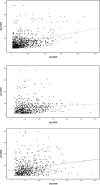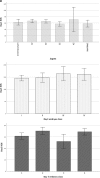Limited relationships between reactive oxygen species levels in culture media and zygote and embryo development
- PMID: 30415468
- PMCID: PMC6420490
- DOI: 10.1007/s10815-018-1363-6
Limited relationships between reactive oxygen species levels in culture media and zygote and embryo development
Abstract
Purpose: Reactive oxygen species (ROS) are thought to play a critical role in the success of IVF. The relationships between oxidative stress parameters in culture media and IVF outcomes have not been extensively investigated. The objective of this study is to examine the relationships between early human embryonic parameters and levels of ROS in culture media.
Methods: This prospective study was conducted with 2633 spent culture media collected from patients undergoing conventional IVF (n = 101) and intracytoplasmic sperm injection (ICSI) (n = 60). Both fertilization and early culture were performed in universal IVF medium and G series medium. ROS levels were measured by chemiluminescence assays using luminol as the probe on days 1, 3, and 5 and determined the relationships of ROS levels with zygote condition, embryo quality, and clinical pregnancy rate.
Results: ROS levels per embryo in culture media on the corresponding days 1, 3, and 5 showed significant correlations between each pair in the total cohort. Similar results were observed in the IVF and ICSI groups, but day 1 and day 3 ROS levels were significantly higher in culture media of IVF than of ICSI embryos. ROS levels in culture medium were not significantly associated with embryo quality, blastocyst formation, or arrest. ROS levels on day 1 were similar in media of normally fertilized zygotes, unfertilized oocytes, and polyspermic zygotes and were not associated with delayed embryonic development, high fragmentation, blastocyst formation, or arrest after prolonged culture. ROS levels in media were not associated with the likelihood of conception.
Conclusions: ROS levels in culture media may not be an effective indicator of embryo selection for IVF.
Keywords: Culture media; Embryo development; Embryo morphology; Fertilization; Reactive oxygen species.
Conflict of interest statement
Conflict of interest
The authors declare that they have no competing interests.
Figures



Similar articles
-
Differential growth of human embryos in vitro: role of reactive oxygen species.Fertil Steril. 2004 Sep;82(3):593-600. doi: 10.1016/j.fertnstert.2004.02.121. Fertil Steril. 2004. PMID: 15374701
-
[Embryo development in two single-step media: Analysis of 2059 sibling oocytes].Gynecol Obstet Fertil. 2016 Mar;44(3):163-7. doi: 10.1016/j.gyobfe.2016.01.005. Epub 2016 Feb 18. Gynecol Obstet Fertil. 2016. PMID: 26908149 French.
-
Long-time exposure of mouse embryos to the sperm produces high levels of reactive oxygen species in culture medium and relates to poor embryo development.Reprod Domest Anim. 2009 Aug;44(4):634-7. doi: 10.1111/j.1439-0531.2007.01036.x. Epub 2008 Nov 18. Reprod Domest Anim. 2009. PMID: 19019063
-
Embryo culture as a diagnostic tool.Reprod Biomed Online. 2003 Dec;7(6):671-82. doi: 10.1016/s1472-6483(10)62090-1. Reprod Biomed Online. 2003. PMID: 14748966 Review.
-
Oxidative stress and its implications in female infertility - a clinician's perspective.Reprod Biomed Online. 2005 Nov;11(5):641-50. doi: 10.1016/s1472-6483(10)61174-1. Reprod Biomed Online. 2005. PMID: 16409717 Review.
Cited by
-
Male factor infertility and placental pathology in singleton live births conceived with in vitro fertilization.J Assist Reprod Genet. 2021 Dec;38(12):3223-3232. doi: 10.1007/s10815-021-02344-5. Epub 2021 Oct 26. J Assist Reprod Genet. 2021. PMID: 34704166 Free PMC article.
-
Cellular and Molecular Nature of Fragmentation of Human Embryos.Int J Mol Sci. 2022 Jan 25;23(3):1349. doi: 10.3390/ijms23031349. Int J Mol Sci. 2022. PMID: 35163271 Free PMC article. Review.
-
Evaluation of the effect of the elective blastocyst-stage embryo transfer and freezing strategy on the abandonment of frozen embryos under the Taiwan National Assisted Reproduction Act.J Assist Reprod Genet. 2020 Apr;37(4):973-982. doi: 10.1007/s10815-020-01699-5. Epub 2020 Jan 28. J Assist Reprod Genet. 2020. PMID: 31989382 Free PMC article.
-
The Impact of Origanum vulgare Supplementation on Human Asthenozoospermic Sperm Parameter Quality.ScientificWorldJournal. 2023 Jun 24;2023:8093795. doi: 10.1155/2023/8093795. eCollection 2023. ScientificWorldJournal. 2023. PMID: 37440992 Free PMC article.
-
Oxidative Stress in Reproduction: A Mitochondrial Perspective.Biology (Basel). 2020 Sep 4;9(9):269. doi: 10.3390/biology9090269. Biology (Basel). 2020. PMID: 32899860 Free PMC article. Review.
References
-
- Gardner DKSW. In-vitro culture of human blastocysts. In: Jansen MD, Mortimer D, editors. Towards reproductive certainty: fertility and genetics beyond 1999. Carnforth: Parthenon Publishing; 1999. pp. 378–388.
MeSH terms
Substances
Grants and funding
LinkOut - more resources
Full Text Sources
Medical

